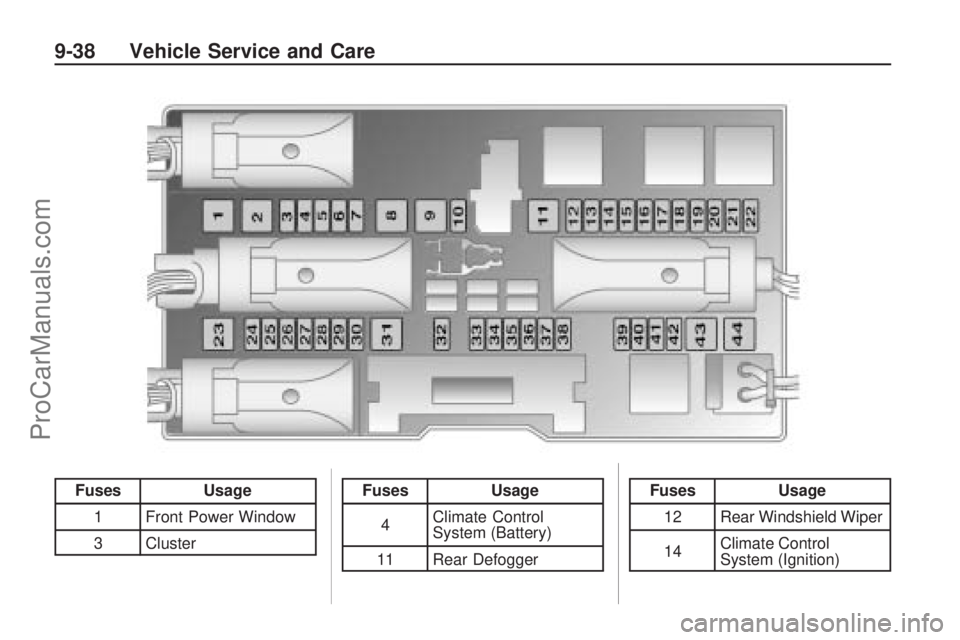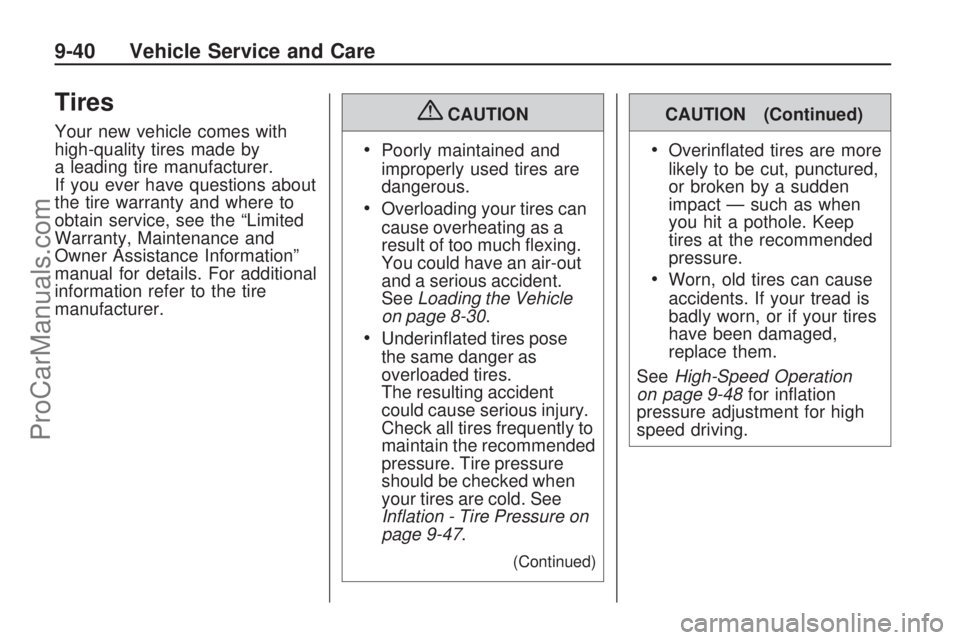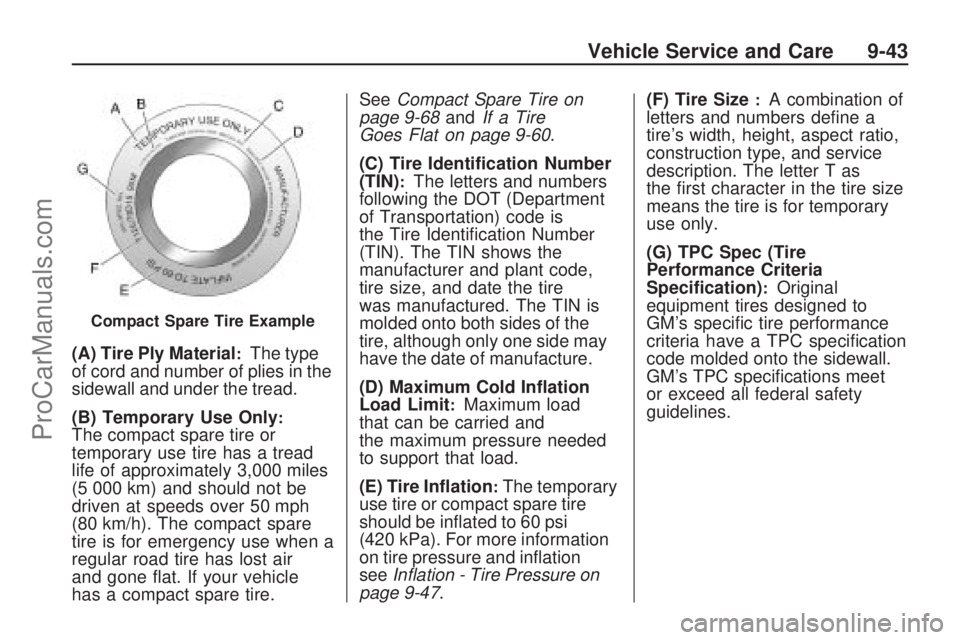SATURN ASTRA 2009 Owners Manual
Manufacturer: SATURN, Model Year: 2009, Model line: ASTRA, Model: SATURN ASTRA 2009Pages: 314, PDF Size: 1.94 MB
Page 221 of 314

Fuses Usage
8 Horn
10 Door Locks
13 Foglamps
14Windshield Wipers
(high speed)
15Windshield Wipers
(low speed)
16Antilock Brake System,
Brake Lamp Switch
17 Vacuum Pump
18 Starter
20 Air Conditioning Clutch
21Engine Control
Module (ECM)
(Main Relay)
22 ECM (Battery)
24 Fuel Pump/Injectors
26ECM (Sensor and
Actuators)Fuses Usage
27 Power Steering
28Automatic
Transmission (Battery)
29Automatic
Transmission (Ignition)
30 ECM (Ignition)
32 Brake Switch
34Steering Column
Module
35 Radio
36OnStar™ Module/
OnStar™ Interface
Module/DisplayRear Compartment
Fuse Block
To open the liftgate, SeeLiftgate on
page 2-6.
The rear compartment fuse block
is located on the left side of
the cargo area behind a cover.
Use the fuse puller, to remove and
replace fuses.
Vehicle Service and Care 9-37
ProCarManuals.com
Page 222 of 314

FusesUsage
1 Front Power Window
3 ClusterFuses Usage
4 Climate Control
System (Battery)
11 Rear DefoggerFuses Usage
12 Rear Windshield Wiper
14 Climate Control
System (Ignition)
9-38 Vehicle Service and Care
ProCarManuals.com
Page 223 of 314

Fuses Usage
16Front Passenger Seat
Detection Sensor
17Tire Pressure
Monitoring
System (TPMS)/Rain
Sensor/Inside
Rearview Mirror
18 Interior Lights
21 Outside Mirror Heating
22 Sunroof
23 Rear Power Window
24Diagnostic Link
Connector
29Accessory Power
Outlet (APO)
34 Sunroof
38 Door Locks
39 Seat Heating Driver
40Seat Heating Front
Passenger
Vehicle Service and Care 9-39
ProCarManuals.com
Page 224 of 314

Tires
Your new vehicle comes with
high-quality tires made by
a leading tire manufacturer.
If you ever have questions about
the tire warranty and where to
obtain service, see the “Limited
Warranty, Maintenance and
Owner Assistance Information”
manual for details. For additional
information refer to the tire
manufacturer.{CAUTION
Poorly maintained and
improperly used tires are
dangerous.
Overloading your tires can
cause overheating as a
result of too much �exing.
You could have an air-out
and a serious accident.
SeeLoading the Vehicle
on page 8-30.
Underin�ated tires pose
the same danger as
overloaded tires.
The resulting accident
could cause serious injury.
Check all tires frequently to
maintain the recommended
pressure. Tire pressure
should be checked when
your tires are cold. See
Inflation - Tire Pressure on
page 9-47.
(Continued)
CAUTION (Continued)
Overin�ated tires are more
likely to be cut, punctured,
or broken by a sudden
impact — such as when
you hit a pothole. Keep
tires at the recommended
pressure.
Worn, old tires can cause
accidents. If your tread is
badly worn, or if your tires
have been damaged,
replace them.
SeeHigh-Speed Operation
on page 9-48for in�ation
pressure adjustment for high
speed driving.
9-40 Vehicle Service and Care
ProCarManuals.com
Page 225 of 314

Low-Pro�le Tires
If the vehicle has 225/40ZR18 or
215/45R18 size tires, they
are classi�ed as low-pro�le
performance tires. These tires
are designed for very responsive
driving on wet or dry pavement.
You may also notice more
road noise with low-pro�le
performance tires and that they
tend to wear faster.
Notice:If the vehicle has
low-pro�le tires, they are more
susceptible to damage from
road hazards or curb impact
than standard pro�le tires.
Tire and/or wheel assembly
damage can occur when
coming into contact with road
hazards like, potholes, or
sharp edged objects, or when
sliding into a curb. The vehicle
warranty does not cover this
type of damage. Keep tires
set to the correct in�ationpressure and, when possible
avoid contact with curbs,
potholes, and other road
hazards.
Winter Tires
If the vehicle has 225/40ZR18 or
215/45R18 size tires, they are
classi�ed as low-pro�le performance
tires. These tires are designed for
very responsive driving on wet or dry
pavement. If you expect to drive
on snow or ice covered roads often,
you may want to get winter tires
for your vehicle. All season tires
provide good overall performance on
most surfaces but they may not
offer the traction you would like or
the same level of performance
as winter tires on snow or ice
covered roads.
Winter tires, in general, are
designed for increased traction
on snow and ice covered roads.With winter tires, there may be
decreased dry road traction,
increased road noise, and shorter
tire tread life. After switching to
winter tires, be alert for changes in
vehicle handling and braking.
See your dealer/retailer for details
regarding winter tire availability
and proper tire selection. Also, see
Buying New Tires on page 9-54.
If you choose to use winter tires:
Use tires of the same brand and
tread type on all four wheel
positions.
Use only radial ply tires of the
same size, load range, and
speed rating as your original
equipment tires.
Winter tires with the same speed
rating as the original equipment tires
may not be available for H, V, W,
Y and ZR speed rated tires.
If you choose winter tires with a
lower speed rating, never exceed
the tire’s maximum speed capability.
Vehicle Service and Care 9-41
ProCarManuals.com
Page 226 of 314

Tire Sidewall Labeling
Useful information about a tire
is molded into its sidewall.
The examples below show a
typical passenger vehicle tire and
a compact spare tire sidewall.
(A) Tire Size
:The tire size is
a combination of letters and
numbers used to de�ne a
particular tire’s width, height,
aspect ratio, construction type,
and service description.See the “Tire Size” illustration
later in this section for more
detail.
(B) TPC Spec (Tire
Performance Criteria
Speci�cation)
:Original
equipment tires designed to
GM’s speci�c tire performance
criteria have a TPC speci�cation
code molded onto the sidewall.
GM’s TPC speci�cations meet
or exceed all federal safety
guidelines.
(C) DOT (Department of
Transportation)
:The
Department of Transportation
(DOT) code indicates that
the tire is in compliance with
the U.S. Department of
Transportation Motor Vehicle
Safety Standards.
(D) Tire Identi�cation Number
(TIN)
:The letters and numbers
following DOT (Department
of Transportation) code is the
Tire Identi�cation Number (TIN).The TIN shows the manufacturer
and plant code, tire size, and
date the tire was manufactured.
The TIN is molded onto both
sides of the tire, although only
one side may have the date
of manufacture.
(E) Tire Ply Material
:The type
of cord and number of plies in the
sidewall and under the tread.
(F) Uniform Tire Quality
Grading (UTQG)
:Tire
manufacturers are required to
grade tires based on three
performance factors: treadwear,
traction, and temperature
resistance. For more information
seeUniform Tire Quality
Grading on page 9-57.
(G) Maximum Cold In�ation
Load Limit
:Maximum load
that can be carried and
the maximum pressure needed
to support that load.
Passenger (P-Metric) Tire
Example
9-42 Vehicle Service and Care
ProCarManuals.com
Page 227 of 314

(A) Tire Ply Material:The type
of cord and number of plies in the
sidewall and under the tread.
(B) Temporary Use Only
:The compact spare tire or
temporary use tire has a tread
life of approximately 3,000 miles
(5 000 km) and should not be
driven at speeds over 50 mph
(80 km/h). The compact spare
tire is for emergency use when a
regular road tire has lost air
and gone �at. If your vehicle
has a compact spare tire.SeeCompact Spare Tire on
page 9-68andIf a Tire
Goes Flat on page 9-60.
(C) Tire Identi�cation Number
(TIN)
:The letters and numbers
following the DOT (Department
of Transportation) code is
the Tire Identi�cation Number
(TIN). The TIN shows the
manufacturer and plant code,
tire size, and date the tire
was manufactured. The TIN is
molded onto both sides of the
tire, although only one side may
have the date of manufacture.
(D) Maximum Cold In�ation
Load Limit
:Maximum load
that can be carried and
the maximum pressure needed
to support that load.
(E) Tire In�ation
:The temporary
use tire or compact spare tire
should be in�ated to 60 psi
(420 kPa). For more information
on tire pressure and in�ation
seeInflation - Tire Pressure on
page 9-47.(F) Tire Size
:A combination of
letters and numbers de�ne a
tire’s width, height, aspect ratio,
construction type, and service
description. The letter T as
the �rst character in the tire size
means the tire is for temporary
use only.
(G) TPC Spec (Tire
Performance Criteria
Speci�cation)
:Original
equipment tires designed to
GM’s speci�c tire performance
criteria have a TPC speci�cation
code molded onto the sidewall.
GM’s TPC speci�cations meet
or exceed all federal safety
guidelines.
Compact Spare Tire Example
Vehicle Service and Care 9-43
ProCarManuals.com
Page 228 of 314

Tire Size
The following illustration shows
an example of a typical
passenger vehicle tire size.
(A) Passenger (P-Metric) Tire
:The United States version of
a metric tire sizing system.
The letter P as the �rst
character in the tire size
means a passenger vehicle tire
engineered to standards set
by the U.S. Tire and Rim
Association.
(B) Tire Width
:The three-digit
number indicates the tire
section width in millimeters from
sidewall to sidewall.
(C) Aspect Ratio
:A two-digit
number that indicates the tire
height-to-width measurements.For example, if the tire size
aspect ratio is 60, as shown in
item C of the illustration, it would
mean that the tire’s sidewall is
60 percent as high as it is wide.
(D) Construction Code
:A letter
code is used to indicate the
type of ply construction in the
tire. The letter R means radial
ply construction; the letter D
means diagonal or bias ply
construction; and the letter B
means belted-bias ply
construction.
(E) Rim Diameter
:Diameter of
the wheel in inches.
(F) Service Description
:These characters represent the
load index and speed rating
of the tire. The load index
represents the load carry
capacity a tire is certi�ed to
carry. The speed rating is the
maximum speed a tire is certi�ed
to carry a load.
Tire Terminology and
De�nitions
Air Pressure:The amount of
air inside the tire pressing
outward on each square inch
of the tire. Air pressure is
expressed in pounds per square
inch (psi) or kilopascal (kPa).
Accessory Weight
:This means
the combined weight of optional
accessories. Some examples
of optional accessories are,
automatic transmission, power
steering, power brakes, power
windows, power seats, and air
conditioning.
Aspect Ratio
:The relationship
of a tire’s height to its width.
Belt
:A rubber coated layer of
cords that is located between the
plies and the tread. Cords may
be made from steel or other
reinforcing materials.
9-44 Vehicle Service and Care
ProCarManuals.com
Page 229 of 314

Bead:The tire bead contains
steel wires wrapped by steel
cords that hold the tire onto
the rim.
Bias Ply Tire
:A pneumatic tire
in which the plies are laid at
alternate angles less than
90 degrees to the centerline
of the tread.
Cold Tire Pressure
:The
amount of air pressure in a
tire, measured in pounds
per square inch (psi) or
kilopascals (kPa) before a tire
has built up heat from driving.
SeeInflation - Tire Pressure on
page 9-47.
Curb Weight
:The weight of a
motor vehicle with standard
and optional equipment including
the maximum capacity of fuel,
oil, and coolant, but without
passengers and cargo.DOT Markings
:A code molded
into the sidewall of a tire
signifying that the tire is in
compliance with the U.S.
Department of Transportation
(DOT) motor vehicle safety
standards. The DOT code
includes the Tire Identi�cation
Number (TIN), an alphanumeric
designator which can also
identify the tire manufacturer,
production plant, brand, and date
of production.
GVWR
:Gross Vehicle Weight
Rating. SeeLoading the Vehicle
on page 8-30.
GAWR FRT
:Gross Axle
Weight Rating for the front axle.
SeeLoading the Vehicle on
page 8-30.
GAWR RR
:Gross Axle
Weight Rating for the rear axle.
SeeLoading the Vehicle on
page 8-30.Intended Outboard Sidewall
:The side of an asymmetrical tire,
that must always face outward
when mounted on a vehicle.
Kilopascal (kPa)
:The metric
unit for air pressure.
Light Truck (LT-Metric) Tire
:A tire used on light duty
trucks and some multipurpose
passenger vehicles.
Load Index
:An assigned
number ranging from 1 to 279
that corresponds to the load
carrying capacity of a tire.
Maximum In�ation Pressure
:The maximum air pressure
to which a cold tire can be
in�ated. The maximum air
pressure is molded onto the
sidewall.
Maximum Load Rating
:The load rating for a tire at the
maximum permissible in�ation
pressure for that tire.
Vehicle Service and Care 9-45
ProCarManuals.com
Page 230 of 314

Maximum Loaded Vehicle
Weight:The sum of curb
weight, accessory weight,
vehicle capacity weight, and
production options weight.
Normal Occupant Weight
:The number of occupants
a vehicle is designed to seat
multiplied by 150 lbs (68 kg).
SeeLoading the Vehicle
on page 8-30.
Occupant Distribution
:Designated seating positions.
Outward Facing Sidewall
:The side of an asymmetrical tire
that has a particular side that
faces outward when mounted on
a vehicle. The side of the tire
that contains a whitewall,
bears white lettering, or bears
manufacturer, brand, and/or
model name molding that
is higher or deeper than the
same moldings on the
other sidewall of the tire.Passenger (P-Metric) Tire
:A tire used on passenger
cars and some light duty trucks
and multipurpose vehicles.
Recommended In�ation
Pressure
:Vehicle
manufacturer’s recommended
tire in�ation pressure as
shown on the tire placard.
SeeInflation - Tire Pressure
on page 9-47andLoading the
Vehicle on page 8-30.
Radial Ply Tire
:A pneumatic
tire in which the ply cords
that extend to the beads are laid
at 90 degrees to the centerline
of the tread.
Rim
:A metal support for a tire
and upon which the tire beads
are seated.
Sidewall
:The portion of a tire
between the tread and the bead.
Speed Rating
:An alphanumeric
code assigned to a tire
indicating the maximum speed
at which a tire can operate.Traction
:The friction between
the tire and the road surface.
The amount of grip provided.
Tread
:The portion of a tire that
comes into contact with the road.
Treadwear Indicators
:Narrow
bands, sometimes called
wear bars, that show across
the tread of a tire when only
1/16 inch (1.6 mm) of tread
remains. SeeWhen It Is Time
for New Tires on page 9-54.
UTQGS (Uniform Tire Quality
Grading Standards)
:A tire
information system that provides
consumers with ratings for a
tire’s traction, temperature,
and treadwear. Ratings are
determined by tire manufacturers
using government testing
procedures. The ratings are
molded into the sidewall of the
tire. SeeUniform Tire Quality
Grading on page 9-57.
9-46 Vehicle Service and Care
ProCarManuals.com